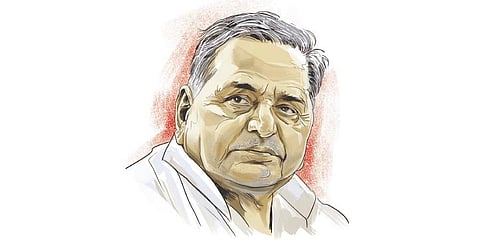

LUCKNOW: If politics is the art of the possible, Mulayam Singh Yadav was its consummate practitioner. Though he was a pivot for opposition politics for decades, he had no problems in praising Narendra Modi in Parliament in 2019, wishing he would return as prime minister after the Lok Sabha elections that year.
He sought to spike Congress leader Sonia Gandhi’s attempt to become PM in 1999 by raking up her foreign origin, but was quite comfortable entering into electoral alliances with her party when it suited him. For that matter, he even tied up with the BJP and the BSP on occasion though he was a Socialist by ideology.
When there was a glimmer of a chance for him to become PM in 1996, Lalu Yadav snuffed it out, yet Mulayam later forged familial and political ties with him. He staunchly opposed the women’s reservation bill in Parliament but had no problems giving party tickets to women in his family.
That was the Netaji of UP the tallest personality in the Hindi heartland spanning over five decades. When his end came following prolonged illness, at Medanta Hospital in Delhi on Monday, he left behind the biggest political dynasty in the country. He was 82. His body has been taken to his native village Saifai for cremation.
Three stints as chief minister of UP, getting elected 10 times as MLA, and seven in Parliament, besides serving as Union defence minister for a couple of years as part of the United Front government, gave him rich experience and honed his survival skills, earning him the moniker of Dhartiputra (son of the soil). He could have taken another shot at power after his Samajwadi Party got a majority on its own for the first time in UP in 2012, but passed on the CM baton to son Akhilesh Yadav.
A wrestler and a teacher in his early life, Mulayam’s entry into politics had its origin in a wrestling match. Then a 28-year-old, he was participating in a match in Mainpuri where he impressed Nathu Singh, the then MLA of Jaswantnagar in Mainpuri with his grappling skills. Nathu Singh chose Mulayam as his protege and fielded him as the candidate on his Jaswantnagar Assembly seat on the Samyukta Socialist Party ticket. Ever since, there was no looking back, as he represented different parties each time till he floated the SP in 1992 at the height of the Ram temple movement.
Born to Murti Devi and Sughar Singh on November 22, 1939, in Saifai, he was a Lohiaite who became a master in political machinations, flooring rivals across the spectrum through what his admirers called his Charkha Daav, using wrestling parlance.
Looked upon as a champion of social justice, Mulayam thrived on anti-Congressism in politics after the departure of Ram Manohar Lohia and Jaiprakash Narain. He became the axis of politics of the backward classes in UP after the Mandal movement. It was he who edged out the Congress from UP and captured its space, becoming the face of the pro-Mandal forces in UP.
The demolition of the disputed structure in Ayodhya in 1992 and incidents before and after it played an important role in Mulayam’s career, especially when hardcore Hindutva politics started taking centrestage. In 1990, he, as CM, ordered police firing on kar sewaks in Ayodhya, which drew Muslims towards the SP. He thus built a formidable M-Y (Muslim-Yadav) combination, ignoring opposition barbs of ‘Mullah Mulayam’.
By 2016, when faultlines within the family emerged as Akhilesh and brother Shivpal squabbled to capture the party, he remained a mute spectator and later sided with his son. The SP’s stock dipped ever since.